Assessment of Indoor Environmental Quality in Budget Hotels Using Text-Mining Method: Case Study of Top Five Brands in China
Abstract
1. Introduction
- How can the content of IEQ complaints be extracted from online reviews?
- What is the overall situation of budget hotel customers’ complaints about IEQ? How serious is each type of IEQ problem?
- What are the sources of IEQ complaints? What are the differences in IEQ complaints between different seasons, zones, customer types and hotel brands?
- What is the relationship between IEQ complaints and customer satisfaction? What is the degree of influence of different IEQ factors?
- How can the IEQ of budget hotels be improved to enhance their competitiveness?
2. Literature Review
2.1. IEQ Factor for Hotels
2.2. Application of Online Reviews
3. Materials and Methods
3.1. Data Collection
3.2. Data Preprocessing
3.3. Identification of IEQ Complaints
3.3.1. Compile IEQ Term Dictionary
3.3.2. Extracting Reviews Containing IEQ Problems
3.3.3. Identification and Deletion of Irrelevant Reviews
3.4. Data Analysis
3.4.1. Measurement of IEQ Complaints
3.4.2. Analysis Dimensions of IEQ Complaints
4. Results and Discussion
4.1. IEQ Complaint Rate Analysis
4.1.1. Overall Analysis of the IEQ Complaint Rate
4.1.2. Analysis of the Complaint Rates of Different IEQ Categories
- Acoustic environment
- IAQ
- Thermal environment
- Luminous environment
4.1.3. Quantitative Analysis of the Simultaneous Occurrence of Multicategory IEQ Problems
4.2. Differentiated Analysis of IEQ Complaints under Different Conditions
4.2.1. Differentiated Analysis of IEQ Complaints in Different Climate Regions
4.2.2. Differentiated Analysis of IEQ Complaints in Different Seasons
4.2.3. Differentiated Analysis of IEQ Complaints for Different Customer Types
4.3. Correlation Analysis of IEQ Complaints and Customer Satisfaction
4.4. Source Analysis of IEQ Complaints
4.4.1. Source Analysis of Acoustic Environmental Complaints
4.4.2. Source Analysis of IAQ Complaints
4.4.3. Source Analysis of Thermal Environment Complaints
4.4.4. Source Analysis of Luminous Environment Complaints
5. Conclusions
Author Contributions
Funding
Institutional Review Board Statement
Informed Consent Statement
Data Availability Statement
Conflicts of Interest
References
- De Giuli, V.; da Pos, O.; de Carli, M. Indoor Environmental Quality and Pupil Perception in Italian Primary Schools. Build. Environ. 2012, 56, 335–345. [Google Scholar] [CrossRef]
- Asadi, A.; Alsubaey, M.; Makatsoris, C. A Machine Learning Approach for Predicting Delays in Construction Logistics. Int. J. Adv. Logist. 2015, 4, 115–130. [Google Scholar] [CrossRef]
- Abbaszadeh, S.; Zagreus, L.; Lehrer, D.; Huizenga, C. Occupant Satisfaction with Indoor Environmental Quality in Green Buildings. Proc. Healthy Build. 2006, 3, 365–370. Available online: https://escholarship.org/uc/item/9rf7p4bs (accessed on 25 March 2020).
- Altomonte, S.; Schiavon, S. Occupant Satisfaction in LEED and Non-LEED Certified Buildings. Build. Environ. 2013, 68, 66–76. [Google Scholar] [CrossRef]
- Altomonte, S.; Schiavon, S.; Kent, M.G.; Brager, G. Indoor Environmental Quality and Occupant Satisfaction in Green-Certified Buildings. Build. Res. Inf. 2019, 47, 255–274. [Google Scholar] [CrossRef]
- Devitofrancesco, A.; Belussi, L.; Meroni, I.; Scamoni, F. Development of an Indoor Environmental Quality Assessment Tool for the Rating of Offices in Real Working Conditions. Sustainability 2019, 11, 1645. [Google Scholar] [CrossRef]
- Kapalo, P.; Vilčeková, S.; Mečiarová, Ľ.; Domnita, F.; Adamski, M. Influence of Indoor Climate on Employees in Office Buildings—A Case Study. Sustainability 2020, 12, 5569. [Google Scholar] [CrossRef]
- Ricciardi, P.; Buratti, C. Thermal Comfort in Open Plan Offices in Northern Italy: An Adaptive Approach. Build. Environ. 2012, 56, 314–320. [Google Scholar] [CrossRef]
- Ricciardi, P.; Buratti, C. Environmental Quality of University Classrooms: Subjective and Objective Evaluation of the Thermal, Acoustic, and Lighting Comfort Conditions. Build. Environ. 2018, 127, 23–36. [Google Scholar] [CrossRef]
- Buratti, C.; Ricciardi, P. Adaptive Analysis of Thermal Comfort in University Classrooms: Correlation between Experimental Data and Mathematical Models. Build. Environ. 2009, 44, 674–687. [Google Scholar] [CrossRef]
- Lopez-Chao, V.; Amado Lorenzo, A.; Luis Saorin, J.; de la Torre-Cantero, J.; Melian-Diaz, D. Classroom Indoor Environment Assessment through Architectural Analysis for the Design of Efficient Schools. Sustainability 2020, 12, 2020. [Google Scholar] [CrossRef]
- Catalina, T.; Iordache, V. IEQ Assessment on Schools in the Design Stage. Build. Environ. 2012, 49, 129–140. [Google Scholar] [CrossRef]
- Qi, M.; Li, X.; Zhu, E.; Shi, Y. Evaluation of Perceived Indoor Environmental Quality of Five-Star Hotels in China: An Application of Online Review Analysis. Build. Environ. 2017, 111, 1–9. [Google Scholar] [CrossRef]
- Suh, M.; Moon, H.; Han, H.; Ham, S. Invisible and Intangible, but Undeniable: Role of Ambient Conditions in Building Hotel Guests’ Loyalty. J. Hosp. Mark. Manag. 2015, 24, 727–753. [Google Scholar] [CrossRef]
- Asadi, E.; Costa, J.J.; Gameiro da Silva, M. Indoor Air Quality Audit Implementation in a Hotel Building in Portugal. Build. Environ. 2011, 46, 1617–1623. [Google Scholar] [CrossRef] [PubMed]
- Kuo, N.-W.; Chiang, H.-C.; Chiang, C.-M. Development and Application of an Integrated Indoor Air Quality Audit to an International Hotel Building in Taiwan. Environ. Monit Assess. 2008, 147, 139–147. [Google Scholar] [CrossRef]
- Chan, W.; Lee, S.-C.; Chen, Y.; Mak, B.; Wong, K.; Chan, C.-S.; Zheng, C.; Guo, X. Indoor Air Quality in New Hotels’ Guest Rooms of the Major World Factory Region. Int. J. Hosp. Manag. 2009, 28, 26–32. [Google Scholar] [CrossRef]
- Chang, H.; Huh, C.; Legendre, T.S.; Simpson, J.J. Exploring Particulate Matter Pollution in Hotel Guestrooms. IJCHM 2020, 32, 1131–1162. [Google Scholar] [CrossRef]
- Jablonska, J.; Trocka-Leszczynska, E. Ergonomics of Sound in a Hotel Environment. In Advances in Human Factors in Architecture, Sustainable Urban Planning and Infrastructure; Charytonowicz, J., Falcão, C., Eds.; Advances in Intelligent Systems and Computing; Springer International Publishing: Cham, Germany, 2020; Volume 966, pp. 57–65. ISBN 978-3-030-20150-0. [Google Scholar]
- Sahid, N.; Rahim, R.; Hamzah, B.; Mulyadi, R. Analysis of Indoor Thermal Comfort of Room Space in the International Standard Hotel Building. ASSRJ 2019, 6, 504–527. [Google Scholar] [CrossRef]
- Hu, X.; Xia, B.; Hu, Y.; Skitmore, M.; Buys, L. What Hinders the Development of Chinese Continuing Care Retirement Community Sector? A News Coverage Analysis. Int. J. Strateg. Prop. Manag. 2019, 23, 108–116. [Google Scholar] [CrossRef]
- Lei, S.S.I.; Nicolau, J.L.; Wang, D. The Impact of Distribution Channels on Budget Hotel Performance. Int. J. Hosp. Manag. 2019, 81, 141–149. [Google Scholar] [CrossRef]
- Tseng, M.-L.; Lin, Y.H.; Lim, M.K.; Teehankee, B.L. Using a Hybrid Method to Evaluate Service Innovation in the Hotel Industry. Appl. Soft Comput. 2015, 28, 411–421. [Google Scholar] [CrossRef]
- Kim, H.J. Service Orientation, Service Quality, Customer Satisfaction, and Customer Loyalty: Testing a Structural Model. J. Hosp. Mark. Manag. 2011, 20, 619–637. [Google Scholar] [CrossRef]
- Jani, D.; Han, H. Personality, Satisfaction, Image, Ambience, and Loyalty: Testing Their Relationships in the Hotel Industry. Int. J. Hosp. Manag. 2014, 37, 11–20. [Google Scholar] [CrossRef]
- Guo, Y.; Barnes, S.J.; Jia, Q. Mining Meaning from Online Ratings and Reviews: Tourist Satisfaction Analysis Using Latent Dirichlet Allocation. Tour. Manag. 2017, 59, 467–483. [Google Scholar] [CrossRef]
- Sharifi, S. Examining the Impacts of Positive and Negative Online Consumer Reviews on Behavioral Intentions: Role of Need for Cognitive Closure and Satisfaction Guarantees. J. Hosp. Mark. Manag. 2019, 28, 397–426. [Google Scholar] [CrossRef]
- Xiang, Z.; Schwartz, Z.; Gerdes, J.H.; Uysal, M. What Can Big Data and Text Analytics Tell Us about Hotel Guest Experience and Satisfaction? Int. J. Hosp. Manag. 2015, 44, 120–130. [Google Scholar] [CrossRef]
- Li, H.; Ye, Q.; Law, R. Determinants of Customer Satisfaction in the Hotel Industry: An Application of Online Review Analysis. Asia Pac. J. Tour. Res. 2013, 18, 784–802. [Google Scholar] [CrossRef]
- Luo, J.; Huang, S.; Wang, R. A Fine-Grained Sentiment Analysis of Online Guest Reviews of Economy Hotels in China. J. Hosp. Mark. Manag. 2021, 30, 71–95. [Google Scholar] [CrossRef]
- Zhao, Y.; Xu, X.; Wang, M. Predicting Overall Customer Satisfaction: Big Data Evidence from Hotel Online Textual Reviews. Int. J. Hosp. Manag. 2019, 76, 111–121. [Google Scholar] [CrossRef]
- Lee, C.C.; Hu, C. Analyzing Hotel Customers’ E-Complaints from an Internet Complaint Forum. J. Travel Tour. Mark. 2004, 17, 167–181. [Google Scholar] [CrossRef]
- Zhou, L.; Ye, S.; Pearce, P.L.; Wu, M.-Y. Refreshing Hotel Satisfaction Studies by Reconfiguring Customer Review Data. Int. J. Hosp. Manag. 2014, 38, 1–10. [Google Scholar] [CrossRef]
- Berezina, K.; Bilgihan, A.; Cobanoglu, C.; Okumus, F. Understanding Satisfied and Dissatisfied Hotel Customers: Text Mining of Online Hotel Reviews. J. Hosp. Mark. Manag. 2016, 25, 1–24. [Google Scholar] [CrossRef]
- Yu, J.; Wang, K.-Y. Online Evaluation and Tourist Purchase Behaviours for Urban Homestay Selection. Int. J. Innov. 2020, 13, 12. [Google Scholar]
- Villeneuve, H.; O’Brien, W. Listen to the Guests: Text-Mining Airbnb Reviews to Explore Indoor Environmental Quality. Build. Environ. 2020, 169, 106555. [Google Scholar] [CrossRef]
- Abdulaali, H.S.; Usman, I.M.S.; Hanafiah, M.M. Online Review Analysis of Perceived Indoor Environmental Quality (IEQ) at Former Green Certified Hotels in Kuala Lumpur, Malaysia. Available online: https://www.researchgate.net/publication/342349062_Online_review_analysis_of_perceived_Indoor_Environmental_Quality_IEQ_at_former_green_certified_hotels_in_Kuala_Lumpur_Malaysia (accessed on 28 January 2021).
- Du, X.; Zhang, Y.; Lv, Z. Investigations and Analysis of Indoor Environment Quality of Green and Conventional Shopping Mall Buildings Based on Customers’ Perception. Build. Environ. 2020, 177, 106851. [Google Scholar] [CrossRef]
- Tran, T.H.; Filimonau, V. The (de)Motivation Factors in Choosing Airbnb amongst Vietnamese Consumers. J. Hosp. Tour. Manag. 2020, 42, 130–140. [Google Scholar] [CrossRef]
- Liu, X.; Hu, W. Attention and Sentiment of Chinese Public toward Green Buildings Based on Sina Weibo. Sustain. Cities Soc. 2019, 44, 550–558. [Google Scholar] [CrossRef]
- Ferster, C.; Laberee, K.; Nelson, T.; Thigpen, C.; Simeone, M.; Winters, M. From Advocacy to Acceptance: Social Media Discussions of Protected Bike Lane Installations. Urban. Stud. 2020, 58, 941–958. [Google Scholar] [CrossRef]
- Kausar, M.A.; Dhaka, V.S.; Singh, S.K. Web Crawler: A Review. IJCA 2013, 63, 31–36. [Google Scholar] [CrossRef]
- Cong, X.; Ma, L.; Wang, L.; Šaparauskas, J.; Górecki, J.; Skibniewski, M.J. The Early Warning System for Determining the “Not In My Back Yard” of Heavy Pollution Projects Based on Public Perception. J. Clean. Prod. 2020, 282, 125398. [Google Scholar] [CrossRef]
- Gupta, V.; Lehal, G.S. A Survey of Text Mining Techniques and Applications. JETWI 2009, 1, 60–76. [Google Scholar] [CrossRef]
- Ezeokoli, F.O.; Omenyi, C.A.; Okonkwo, C.B.N.B.; Iheama, N.B. The Perception of the Indoor Environment Quality (IEQ) of Private Hostels in Ifite-Awka, Nigeria. JENRR 2020, 5, 61–70. [Google Scholar] [CrossRef]
- Abdulaali, H.S.; Hanafiah, M.M.; Usman, I.M.S.; Nizam, U.M.; Abdulhasan, M.J. A Review on Green Hotel Rating Tools, Indoor Environmental Quality (IEQ) and Human Comfort. Int. J. Adv. Sci. Technol. 2020, 29, 30. [Google Scholar]
- Takigawa, T.; Wang, B.-L.; Sakano, N.; Wang, D.-H.; Ogino, K.; Kishi, R. A Longitudinal Study of Environmental Risk Factors for Subjective Symptoms Associated with Sick Building Syndrome in New Dwellings. Sci. Total Environ. 2009, 407, 5223–5228. [Google Scholar] [CrossRef]
- Adgate, J.L.; Goldstein, B.D.; McKenzie, L.M. Potential Public Health Hazards, Exposures and Health Effects from Unconventional Natural Gas Development. Environ. Sci. Technol. 2014, 48, 8307–8320. [Google Scholar] [CrossRef]
- Olesen, B.W. The Philosophy behind EN15251: Indoor Environmental Criteria for Design and Calculation of Energy Performance of Buildings. Energy Build. 2007, 39, 740–749. [Google Scholar] [CrossRef]
- Okamoto-Mizuno, K.; Mizuno, K. Effects of Thermal Environment on Sleep and Circadian Rhythm. J. Physiol. Anthr. 2012, 31, 14. [Google Scholar] [CrossRef]
- Musa, A.R.; Abdullah, N.A.G.; Che-Ani, A.I.; Tawil, N.M.; Tahir, M.M. Indoor Environmental Quality for UKM Architecture Studio: An Analysis on Lighting Performance. Procedia Soc. Behav. Sci. 2012, 60, 318–324. [Google Scholar] [CrossRef]
- Spilak, M.P.; Frederiksen, M.; Kolarik, B.; Gunnarsen, L. Exposure to Ultrafine Particles in Relation to Indoor Events and Dwelling Characteristics. Build. Environ. 2014, 74, 65–74. [Google Scholar] [CrossRef]
- Jian, Y.; Guo, Y.; Liu, J.; Bai, Z.; Li, Q. Case Study of Window Opening Behavior Using Field Measurement Results. Build. Simul. 2011, 4, 107–116. [Google Scholar] [CrossRef]
- Lai, A.C.K.; Mui, K.W.; Wong, L.T.; Law, L.Y. An Evaluation Model for Indoor Environmental Quality (IEQ) Acceptance in Residential Buildings. Energy Build. 2009, 41, 930–936. [Google Scholar] [CrossRef]
- Yao, M.; Zhao, B. Window Opening Behavior of Occupants in Residential Buildings in Beijing. Build. Environ. 2017, 124, 441–449. [Google Scholar] [CrossRef]
- Zuhaib, S.; Manton, R.; Griffin, C.; Hajdukiewicz, M.; Keane, M.M.; Goggins, J. An Indoor Environmental Quality (IEQ) Assessment of a Partially-Retrofitted University Building. Build. Environ. 2018, 139, 69–85. [Google Scholar] [CrossRef]
- Pellerin, N.; Candas, V. Effects of Steady-State Noise and Temperature Conditions on Environmental Perception and Acceptability. Indoor Air 2004, 14, 129–136. [Google Scholar] [CrossRef]
- Lan, L.; Wargocki, P.; Wyon, D.P.; Lian, Z. Effects of Thermal Discomfort in an Office on Perceived Air Quality, SBS Symptoms, Physiological Responses, and Human Performance: The Effects of Thermal Discomfort on Health and Human Performance. Indoor Air 2011, 21, 376–390. [Google Scholar] [CrossRef]
- Fisk, W.J. Review of Some Effects of Climate Change on Indoor Environmental Quality and Health and Associated No-Regrets Mitigation Measures. Build. Environ. 2015, 86, 70–80. [Google Scholar] [CrossRef]
- Huang, L.; Zhu, Y.; Ouyang, Q.; Cao, B. A Study on the Effects of Thermal, Luminous, and Acoustic Environments on Indoor Environmental Comfort in Offices. Build. Environ. 2012, 49, 304–309. [Google Scholar] [CrossRef]
- Dolnicar, S. Business Travellers’ Hotel Expectations and Disappointments: A Different Perspective to Hotel Attribute Importance Investigation. Asia Pac. J. Tour. Res. 2002, 7, 29–35. [Google Scholar] [CrossRef]
- Ariffin, A.A.M.; Maghzi, A. A Preliminary Study on Customer Expectations of Hotel Hospitality: Influences of Personal and Hotel Factors. Int. J. Hosp. Manag. 2012, 31, 191–198. [Google Scholar] [CrossRef]
- Wang, L.; Wang, X.; Peng, J.; Wang, J. The Differences in Hotel Selection among Various Types of Travellers: A Comparative Analysis with a Useful Bounded Rationality Behavioural Decision Support Model. Tour. Manag. 2020, 76, 103961. [Google Scholar] [CrossRef]
- Babin, B.J.; Attaway, J.S. Atmospheric Affect as a Tool for Creating Value and Gaining Share of Customer. J. Bus. Res. 2000, 49, 91–99. [Google Scholar] [CrossRef]
- Rivers, M.J.; Toh, R.S.; Alaoui, M. Frequent-Stayer Programs: The Demographic, Behavioral, and Attitudinal Characteristics of Hotel Steady Sleepers. J. Travel Res. 1991, 30, 41–45. [Google Scholar] [CrossRef]
- Baliatsas, C.; van Kamp, I.; van Poll, R.; Yzermans, J. Health Effects from Low-Frequency Noise and Infrasound in the General Population: Is It Time to Listen? A Systematic Review of Observational Studies. Sci. Total Environ. 2016, 557–558, 163–169. [Google Scholar] [CrossRef] [PubMed]
- Payne, S.R. The Production of a Perceived Restorativeness Soundscape Scale. Appl. Acoust. 2013, 74, 255–263. [Google Scholar] [CrossRef]
- Sun, B.; Liu, L.Y.; Chan, W.W.; Zhang, C.X.; Chen, X. Signals of Hotel Effort on Enhancing IAQ and Booking Intention: Effect of Customer’s Body Mass Index Associated with Sustainable Marketing in Tourism. Sustainability 2021, 13, 1279. [Google Scholar] [CrossRef]
- Szczurek, A.; Maciejewska, M.; Teuerle, M.; Wyłomańska, A. Method to Characterize Collective Impact of Factors on Indoor Air. Phys. A Stat. Mech. Its Appl. 2015, 420, 190–199. [Google Scholar] [CrossRef]
- Kosonen, R.; Tan, F. The Effect of Perceived Indoor Air Quality on Productivity Loss. Energy Build. 2004, 36, 981–986. [Google Scholar] [CrossRef]
- Esfandiari, M.; Mohamed Zaid, S.; Ismail, M.A. Investigating the Indoor Environment Quality Parameters and Their Relationship with Occupants’ Satisfaction in Office Buildings: A Review. JDBE 2017, 181–194. [Google Scholar] [CrossRef]
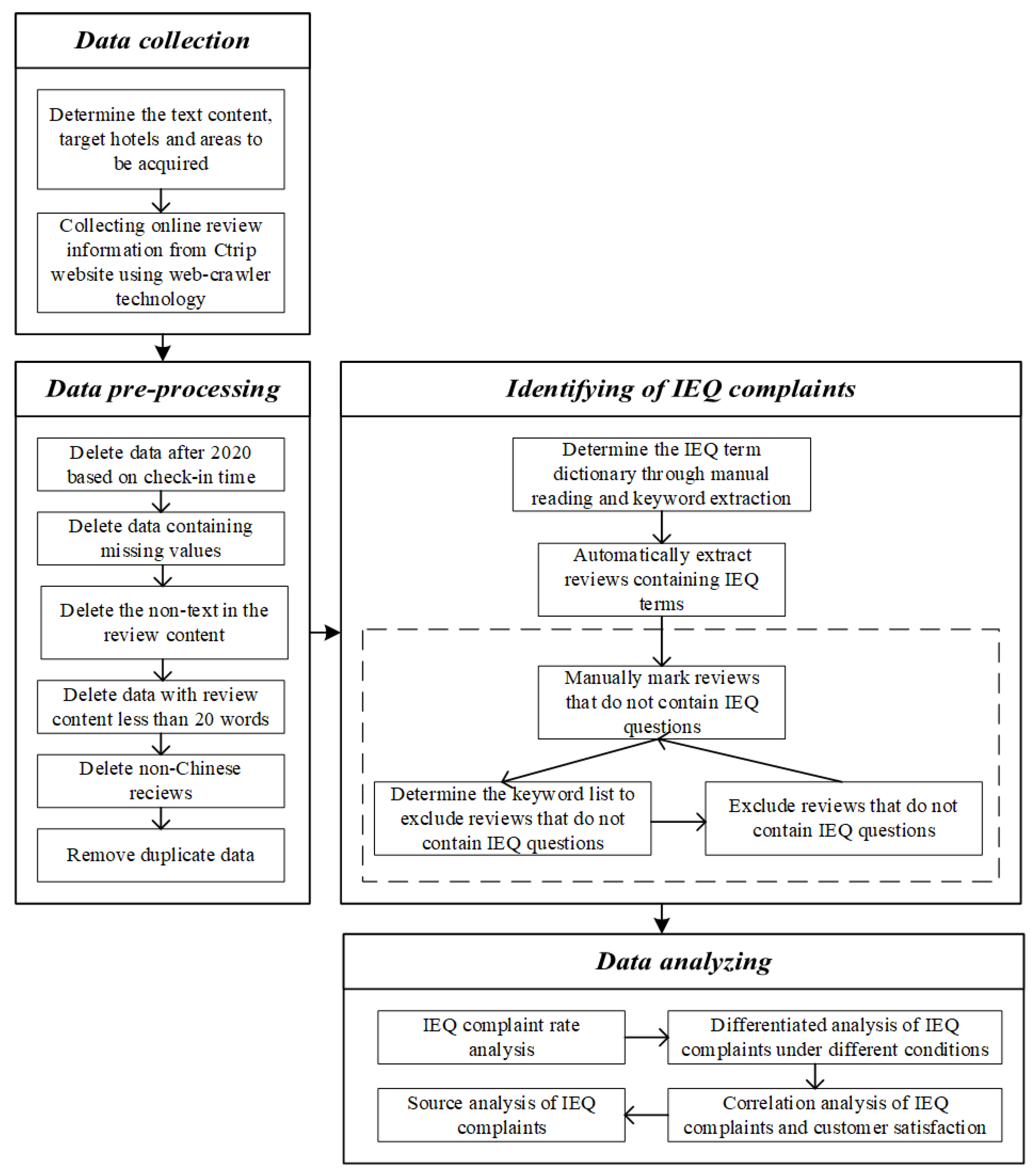
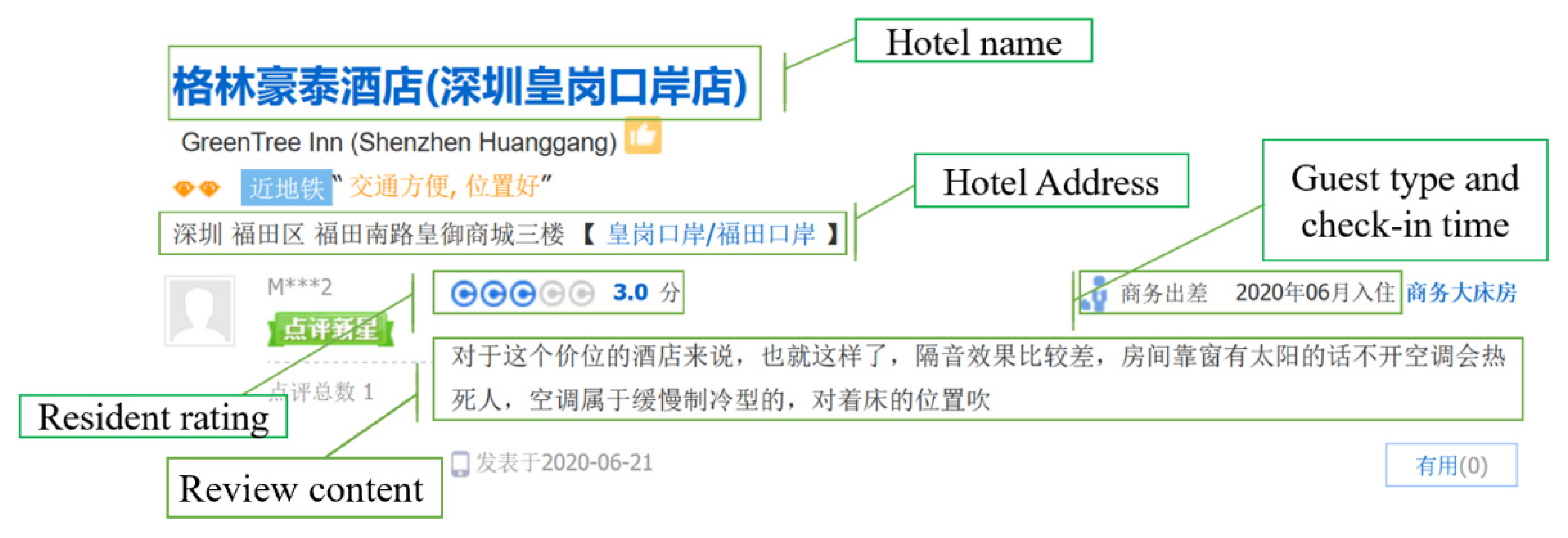
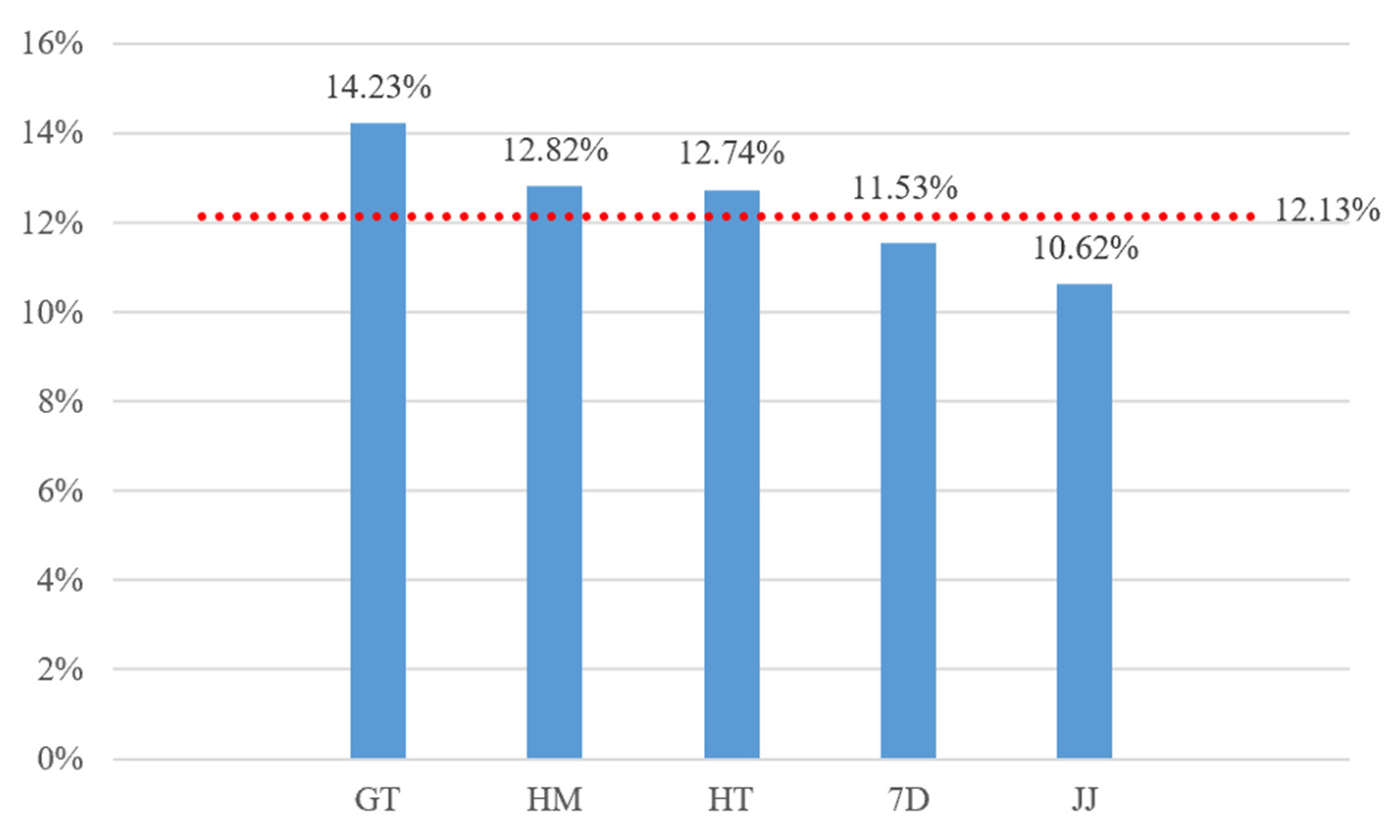
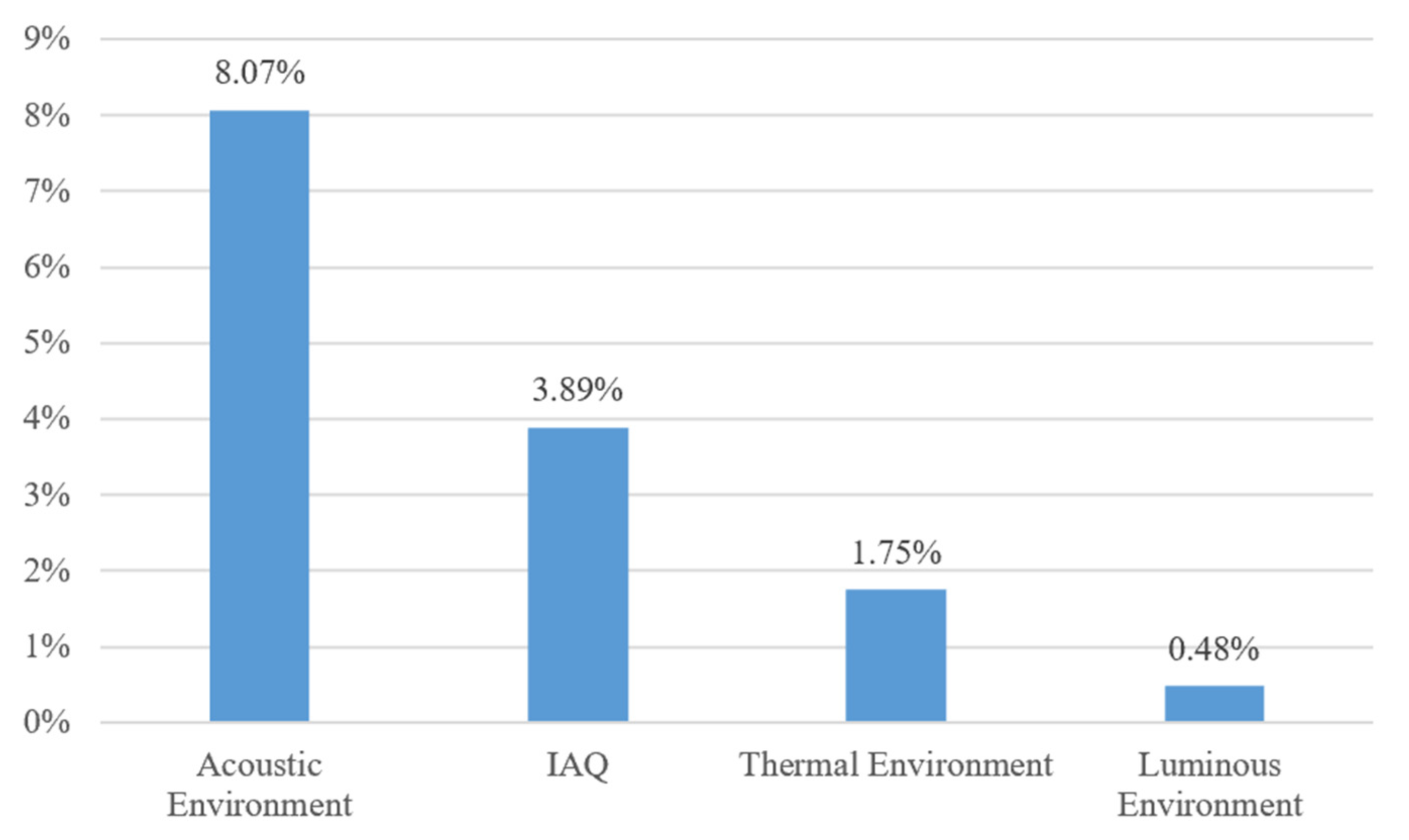
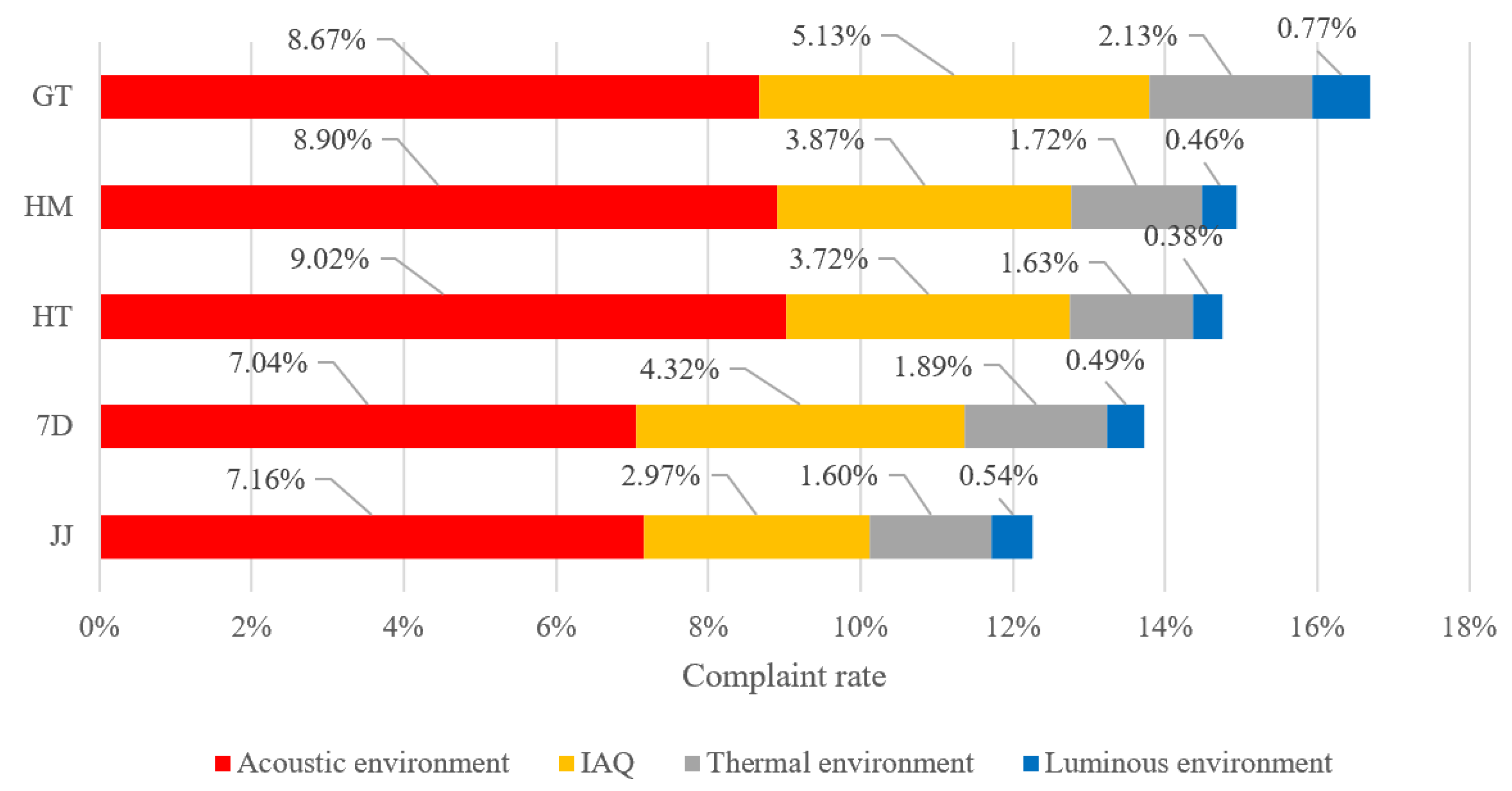
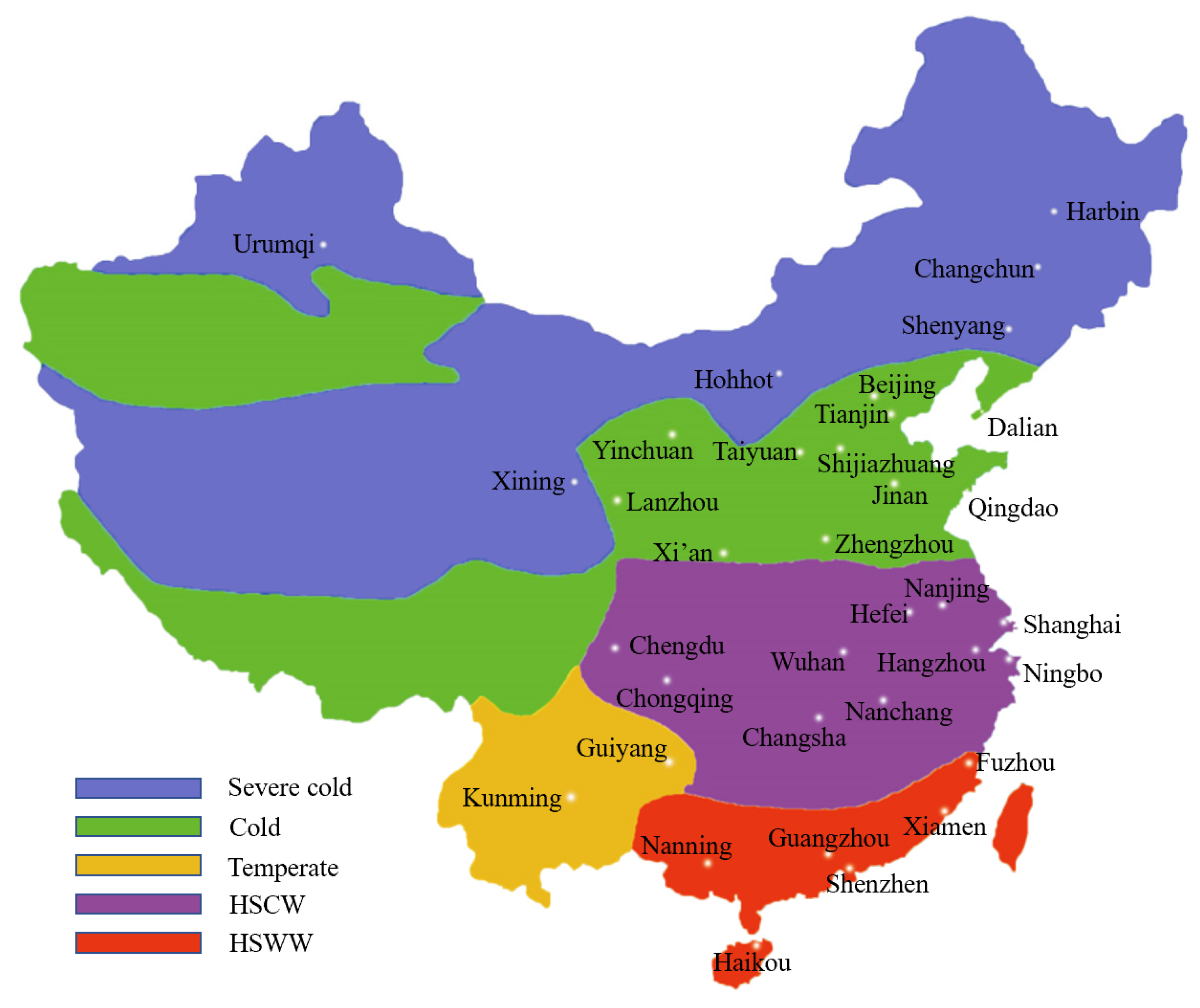
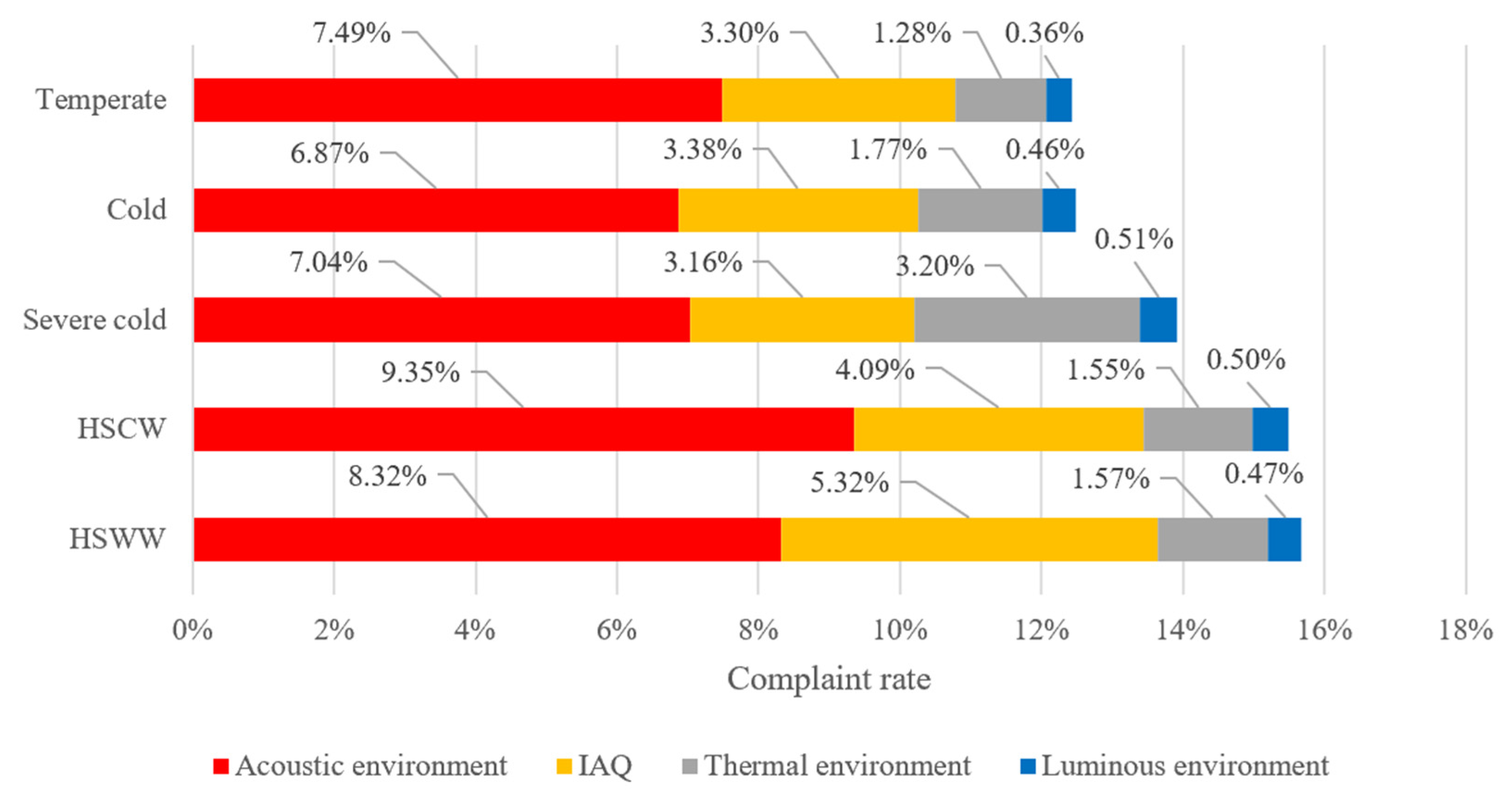
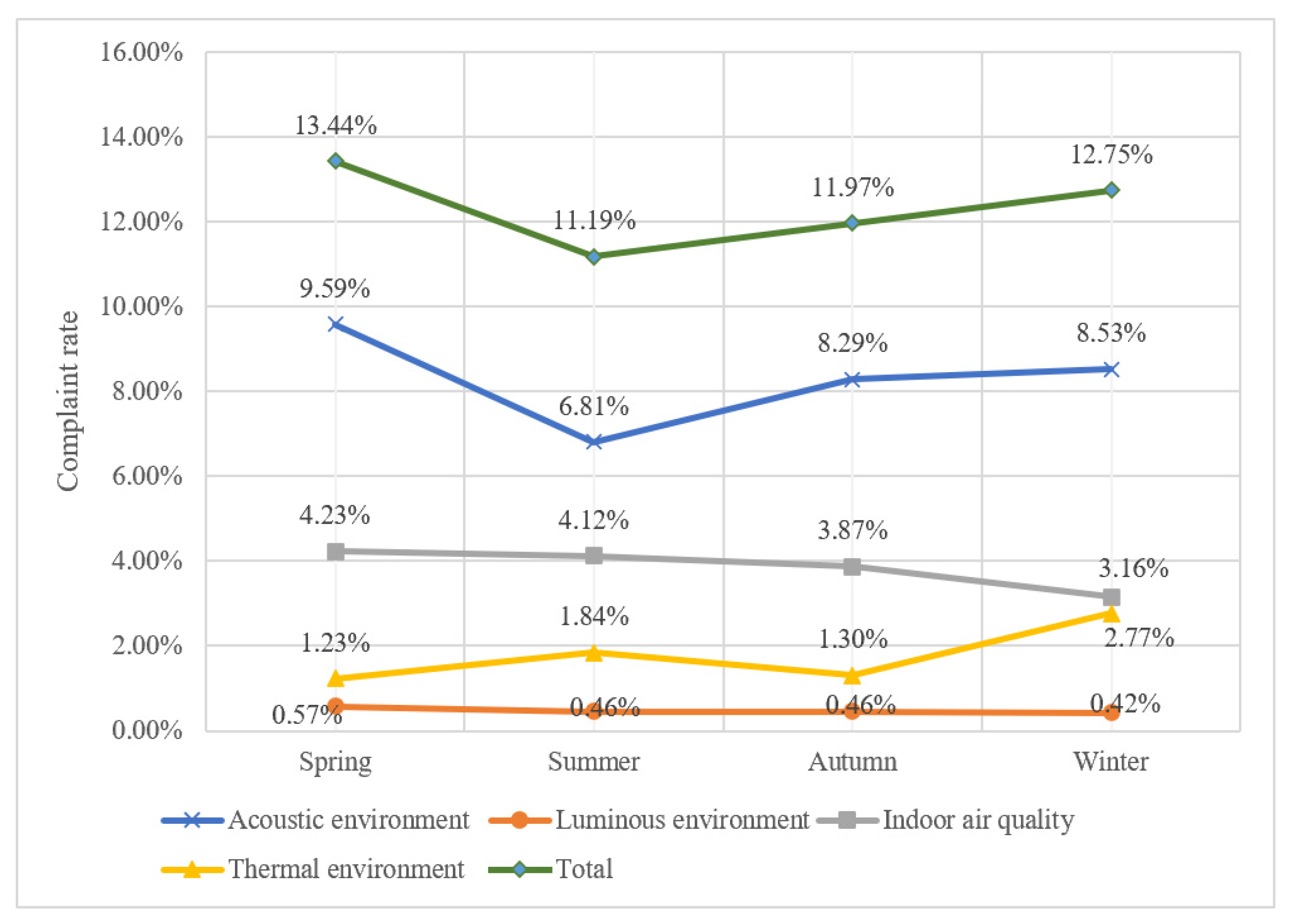
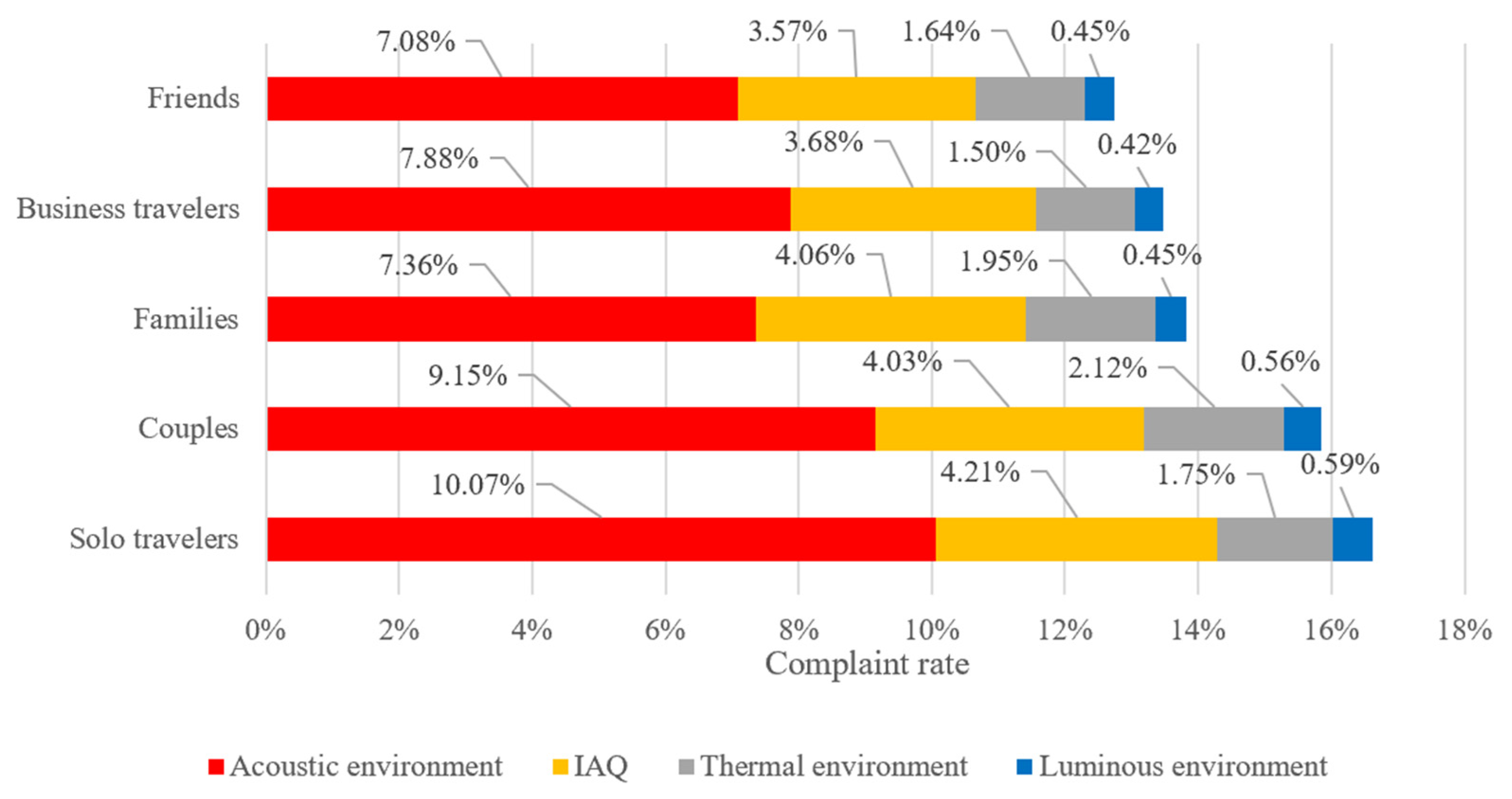
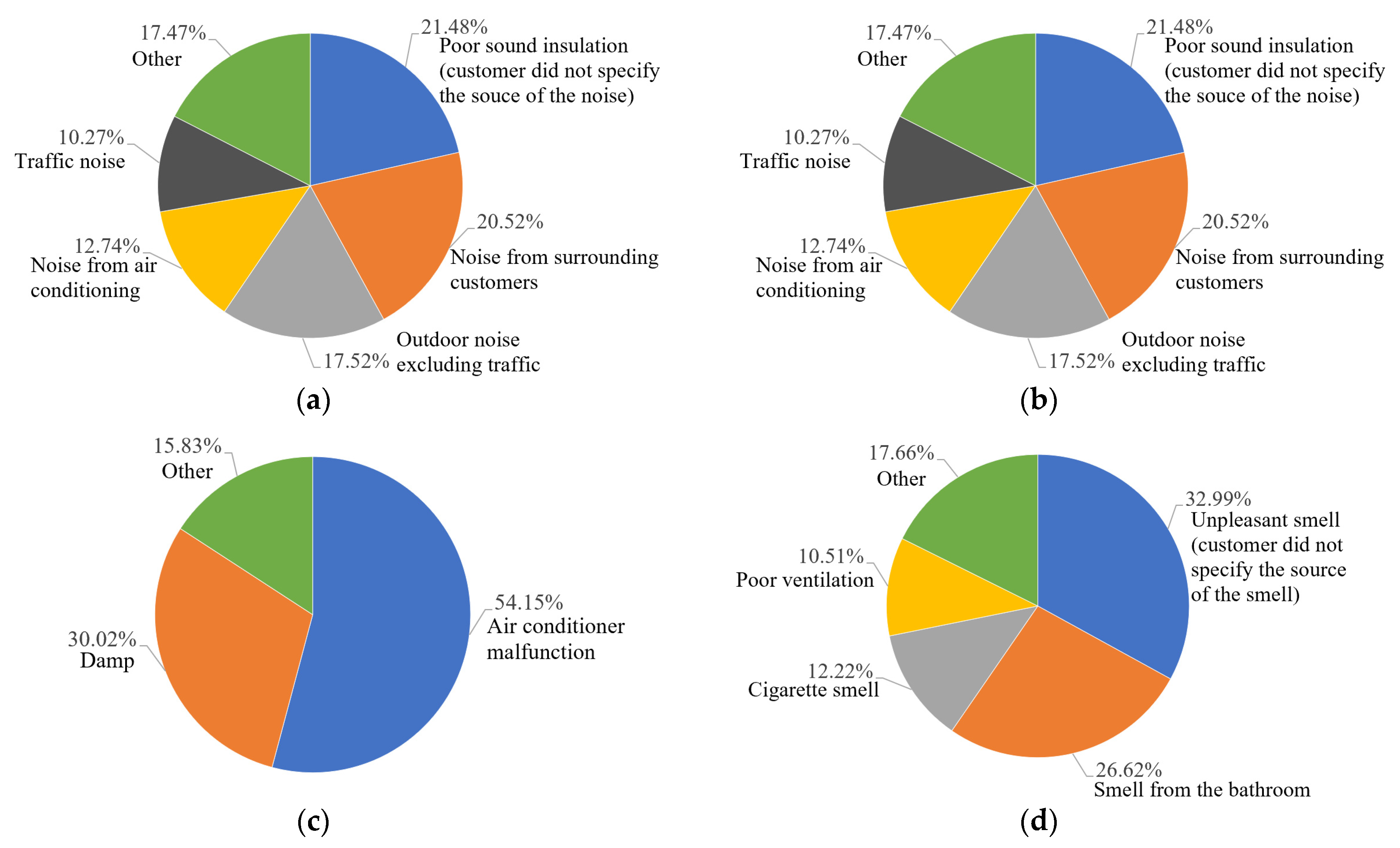
| Hotel Brand | Number of Hotels | Results of Data Processing | |
|---|---|---|---|
| Raw Data | Valid Data | ||
| HM | 981 | 550,143 | 171,094 |
| 7D | 1005 | 618,282 | 211,722 |
| HT | 1296 | 473,637 | 159,578 |
| JJ | 313 | 316,623 | 105,319 |
| GT | 456 | 107,677 | 32,437 |
| Total | 4051 | 2,066,362 | 680,150 |
| IEQ Category | Phrases of IEQ Complaint |
|---|---|
| Acoustic environment | poor sound insulation, bad sound insulation, no sound insulation, very noisy, relatively noisy, a little noisy, loud noise, severe noise, audible noise, some noise, loud voice |
| Luminous environment | dim, dark, very dark, relatively dark, dark room, poor lighting, no sunlight, no light source, not bright, opaque, broken lamp |
| IAQ | peculiar smell, smoke smell, musty smell, sewage smell, big smell, heavy smell, decoration smell, unpleasant smell, poor ventilation, no ventilation, airtight, poor air, bad air |
| Thermal environment | cold, very cold, freezing, too hot, awake from heat, a little hot, very hot, stuffy, wet, damp, very dry, relatively dry, no heating, poor heating, not warm, insufficient heating, faulty air conditioner, no air conditioner |
| Acoustic Environment | Luminous Environment | IAQ | Thermal Environment | |
|---|---|---|---|---|
| Acoustic environment | 54,891 | 547 | 4118 | 1896 |
| Luminous environment | 3232 | 478 | 251 | |
| IAQ | 26,490 | 1621 | ||
| Thermal environment | 11,907 |
| Category | Number |
|---|---|
| Acoustic, thermal and IAQ | 499 |
| Acoustic, visual and IAQ | 123 |
| Thermal, visual and IAQ | 90 |
| Acoustic, visual and thermal | 80 |
| Total | 792 |
| y | Coef. | Std. Err | t | p > |t| |
|---|---|---|---|---|
| x1 | −0.635 | 0.266 | −23.830 | 0.000 |
| Coef. | Std. Err | t | p > |t| | Vif | |
|---|---|---|---|---|---|
| X2 | −0.291 | −0.030 | −9.570 | 0.000 | 1.030 |
| X3 | −0.291 | −0.0256 | −11.370 | 0.000 | 1.030 |
| X4 | −0.655 | −0.037 | −17.560 | 0.000 | 1.070 |
| X5 | −0.453 | −0.042 | −10.680 | 0.000 | 1.030 |
Publisher’s Note: MDPI stays neutral with regard to jurisdictional claims in published maps and institutional affiliations. |
© 2021 by the authors. Licensee MDPI, Basel, Switzerland. This article is an open access article distributed under the terms and conditions of the Creative Commons Attribution (CC BY) license (https://creativecommons.org/licenses/by/4.0/).
Share and Cite
Shen, Z.; Yang, X.; Liu, C.; Li, J. Assessment of Indoor Environmental Quality in Budget Hotels Using Text-Mining Method: Case Study of Top Five Brands in China. Sustainability 2021, 13, 4490. https://doi.org/10.3390/su13084490
Shen Z, Yang X, Liu C, Li J. Assessment of Indoor Environmental Quality in Budget Hotels Using Text-Mining Method: Case Study of Top Five Brands in China. Sustainability. 2021; 13(8):4490. https://doi.org/10.3390/su13084490
Chicago/Turabian StyleShen, Zhifeng, Xirui Yang, Chunlu Liu, and Junjie Li. 2021. "Assessment of Indoor Environmental Quality in Budget Hotels Using Text-Mining Method: Case Study of Top Five Brands in China" Sustainability 13, no. 8: 4490. https://doi.org/10.3390/su13084490
APA StyleShen, Z., Yang, X., Liu, C., & Li, J. (2021). Assessment of Indoor Environmental Quality in Budget Hotels Using Text-Mining Method: Case Study of Top Five Brands in China. Sustainability, 13(8), 4490. https://doi.org/10.3390/su13084490







